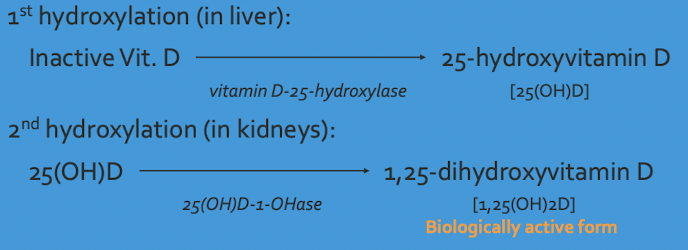Clinical Chem Vitamins & Minerals
Learning Outcome
- To understand the roles of vitamins and minerals important to human health
- To understand the impact on human health due to deficiency of important vitamins and minerals
Micronutrients
Macronutrients
- made up the bulk of the nutrition in food, i.e., carbohydrates, fats, and proteins
- supply calories and act as the building blocks for muscles and tissues
Micronutrients are….
- essential dietary components for the maintenance of health
- deficiency can cause severe and life-threatening clinical disorders
- disproportionately common in low- and middle-income countries
- mostly preventable through
- nutrient education
- consumption of healthy diet
- food fornication and supplementation
Fat-soluble vitamins
- Lipophilic, hydrophobic molecules
- incorporated into mixed micelles to be absorbed from intestine lume
- upon absorption, the fat soluble vitamins are incorporated into chylomicrons
- transport via the lymph into peripheral blood circulation
- stored in the liver and adipose tissues
- deficiencies occur with the malabsorption of fat
Vitamin A
- mainly consists of retinol and retinyl esters
- Two sources:
- performed vitamin A (aka retinol and retinyl esters)
- diary products, eggs, fish and liver
- provitamin A carotenoids (beta-carotene)
- green leafy vegetables, carrots and cantaloupe
- physiological roles:
- vision
- maintain healthy cell-mediated immunity
- differentiation of certain tissues
- morphogenesis in developing embryos
- deficiency
- still common in developing countries due to poverty or traditional diets
- night blindness, conjunctival keratosis, degeneration of cornea
- abnormal lung development, respiratory diseases, anaemia and severe infection
- Excess
- acute vitamin A toxicity (hypervitaminosis)
- severe headache, blurred vision, nausea, dizziness, aching muscles, coordination problems
- chronic hypervitaminosis
- dry skin, painful muscles and joints, fatigue, depression
Vitamin D (calciferol)
Two forms: vitamin D2, vitamin D3
Sources:
- naturally found in certain food, e.g., salmon, mackerel, sardines & mushrooms
- fortified milk, fortified cereal and fortified juice, dietary supplement
- produced endogenously in the skin when exposed to direct sunlight
Activation of vitamin D
biologically inert and must undergo two hydrocylation steps for activation

Physiological roles:
- promote calcium absorption in the intestines
- maintain normal bone mineralisation & prevent hypocalcemia
- bone growth and bone remodelling
- regulate genes involved in cell proliferation, differentiation and apoptosis
- reduce inflammation
- modulate cell growth, neuromuscular & immune function and glucose metabolism
serum concentration of 25 (OH)D → assess the vitamin D status
Vitamin D deficiency
- Causes:
- limited exposure to sunlight
- low intake
- failure of kidneys to convert 25(OH)D to its active form
- inadequate vitamin D absorption
- drugs
- chronic diseases
- Clinical manifestations
- rickets in children → soft bones & skeletal deformities
- severe rickets cases → failur to thrive, developemtnal delay, hypocalcemic seizures, tetanic spasms, cardiomyopathy & dental abnormalities
- osteomalacia in adolescents & adults
- inadequate bone mineralisation during remodeling process
- bone deformities, pain, hypocalcemic seizures, tetanic spasms & dental abnormalities
Vitamin E (alpha-tocopherol)
- exists in 8 naturally occurring plant rocopherols and tocotrienols
- alpha-, beta-, gamma-, and delta-tocopherol
- alpha-, beta-, gamma-, and delta-tocotrienol
- alpha-tocopherol is the only biologically active form in human
- sources:
- plants oil, almonds, peanuts, leafy greens, poultry, eggs, dairy, fortified cereals, oral supplement in capsule or drops
- physiological roles:
- important to vision, reproduction and the health of blood, brain and skin
- as an antioxidant and free radicals scavenger
- protect cells from damaging effects of free radicals
- maintain integrity of all cell membranes
Vitamin E deficiency
- Rare; could be found in premature babies of very low birth rate
- oxidative destruction of membrane phospholipids, e.g.,
- red blood cell fragility leading to haemolytic anemia
- neuronal degeneration leading to peripheral neuropathies
- genetic abnormalities associated with vitamin E metabolism
abetalipoproteinemia
poor absorption of dietary fat
- inadequate vitamin E delivery to tissues
- poor transmission of nerve impulses, muscle weakness, retinal degeneration
Friedreich type of spinocerebellar ataxia
defects in hepatic alpha-tocopherol transferase
- develop nerve damage, lose the ability to walk
Vitamin K
- Vitamin K1; Vitamin K2
- Phylloquinone
- present primarily in green leafy vegetables
- main dietary form of vitamin L
- Menaquinones
- predominantly bacterial origin
- present in modest amount in animal-based or fermented foods
- Sources:
- green leafy vegetables
- vegetable oils
- cereals
- others such as meat, fish & dairy products
- can be synthesised by Gram-positive bacteria in the jejunum & ileum
- Physiological roles
- act as coenzyme for vitamin K-dependent carboxylase involved in the post-translational y-carboxylation of proteins
- increase the capacity of proteins to bind to calcium
- procoagulant proteins of the clotting cascade
- anticoagulant proteins
- bone matrix proteins
- proteins of the renal epithelium
Deficiency of Vit K
- Clinical manifestation
- bleeding and haemorrhage
- reduce bone mineralisation → osteoporosis
- newborns are more susceptible due to
- low placental transfer of vit k
- lack of vit k in breast milk
- bacterial flora not yet established
- adults limited to malabsorption disorder or drugs that interfere with vit k metabolism